Bulletin – December 2015 Australian Economy Firm-level Capacity Utilisation and the Implications for Investment, Labour and Prices
- Download the article 257KB
Abstract
Business surveys provide a timely read of the average rate of capacity utilisation at Australian firms. However, discussions with company managers in the Reserve Bank's business liaison program reveal considerable variation in how ‘capacity utilisation’ is interpreted. This variation is important, as it affects the interpretation of survey measures of capacity utilisation and their implications for firms' resourcing needs and pricing decisions. For firms in the more capital-intensive goods-related industries, a high level of capacity utilisation may reveal an impetus to hire more labour and to invest in the capital stock, while for services firms it is more likely to reflect an incentive to hire more labour only. Consequently, movements in aggregate measures of capacity utilisation are likely to contain information about the labour market, while the implications for business investment are likely to be identified at a more granular level. Much of the recent increase in survey measures of capacity utilisation has been driven by services firms. In contrast, capacity utilisation remains relatively low for firms in goods-related industries, which may help to explain why aggregate capital expenditure has remained subdued.
Introduction
Measures of spare capacity in the economy provide a gauge of price pressures and the outlook for demand for labour and capital inputs. Firms operating close to full capacity are more likely to invest in additional capital and/or employ more workers in order to increase their output, and may also be more likely to increase the prices of their output. In contrast, when capacity utilisation is low, a firm can increase output by utilising its existing labour and capital more intensively.
There are different ways of measuring spare capacity in the economy, such as the unemployment rate or measures of the output gap, which involves estimating the difference between actual and potential output in the economy. These measures can be complemented by measures of firm-level capacity utilisation from business surveys, which are often more timely. However, discussions with firms in the Bank's business liaison program suggest that the interpretation of ‘capacity utilisation’ is not straightforward and varies considerably across the different sectors of the economy.[1]
Survey Measures of Capacity Utilisation
Several private business surveys provide information on the rate of capacity utilisation in Australian businesses. The Reserve Bank monitors these surveys, since they each provide complementary information on capacity pressures in different industries (Table 1). The Australian Chamber of Commerce and Industry-Westpac (ACCI-Westpac) Survey of Industrial Trends, which began in 1961, reports the average rate of capacity utilisation for a sample of manufacturing firms each quarter. The Australian Industry Group (AIG) reports capacity utilisation in the manufacturing, construction and service industries. The broadest survey is conducted by National Australia Bank (NAB), and covers all non-farm industries, including firms involved in the production and distribution of goods, as well as household and business service firms. In addition to questions about the rate of capacity utilisation, the ACCI-Westpac and NAB surveys ask respondents to identify the most significant constraint on business activity from a range of options related to demand, labour, capital and other factors. The NAB survey also asks about the extent to which these factors are a constraint on output.
| Survey | Industries | Sample size and frequency | Start of series | Questions |
|---|---|---|---|---|
| ACCI-Westpac Survey of Industrial Trends | Manufacturing | 200–300 per quarter | September 1961 | Rate of capacity utilisation Single most important constraint |
| AIG Performance of Manufacturing | Manufacturing | 900 per quarter; 200 per month | Quarterly from September 1992; monthly from September 2007 | Rate of capacity utilisation |
| AIG Performance of Construction | Construction | 150 per month | January 2008 | Rate of capacity utilisation |
| AIG Performance of Services | Services | 200 per month | October 2007 | Rate of capacity utilisation |
| NAB Quarterly Business Survey; NAB Monthly Business Survey | Non-farm | 900 per quarter; 400–500 per month | Quarterly from September 1989; monthly from March 1997 | Rate of capacity utilisation Single most important constraint Severity of constraints |
|
Sources: ACCI-Westpac; AIG; NAB |
||||
Recent trends
Survey measures suggest that aggregate capacity utilisation has increased gradually over the past two years (Graph 1). Although an improvement in capacity utilisation is typically thought of as a precondition for an increase in business investment, information from the Australian Bureau of Statistics (ABS) capital expenditure survey, the relatively low level of non-residential building approvals and liaison with firms all suggest that the near-term outlook for investment remains subdued. Moreover, the industry-level data available from the NAB survey suggest that the recent increase in utilisation has been particularly pronounced in the services sector, which is relatively labour intensive (Graph 2). Capacity utilisation in goods-related industries remains low relative to its historical average.
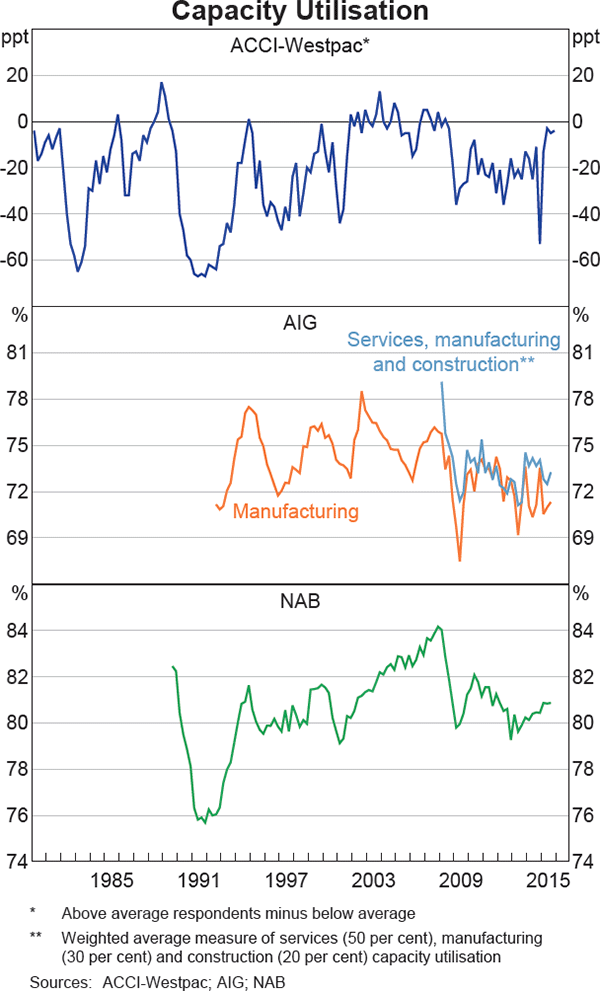
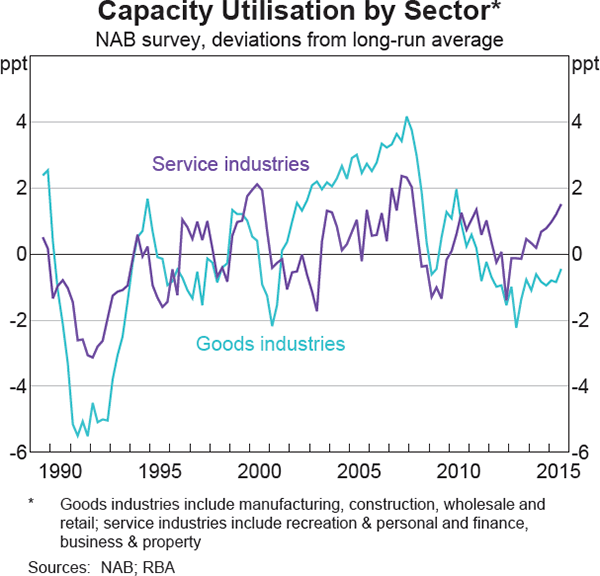
Although the NAB measure of capacity utilisation has increased of late, it suggests that most firms have adequate capital equipment available. Only around one-fifth of respondents reported that ‘premises and plant’ was a constraint on output in the September quarter, a share that has been broadly steady since 2008 (Graph 3). The availability of suitable labour is identified as a constraint by more firms, and in general this appears to have been an important driver of aggregate shifts in capacity utilisation through time. However, a lack of sales and orders is identified by most firms as a constraint on output at present. These observations are broadly consistent with the qualitative read provided by the business liaison program; many firms report that they have adequate plant & equipment to meet current and expected demand, while voluntary staff turnover is low and labour availability is good.
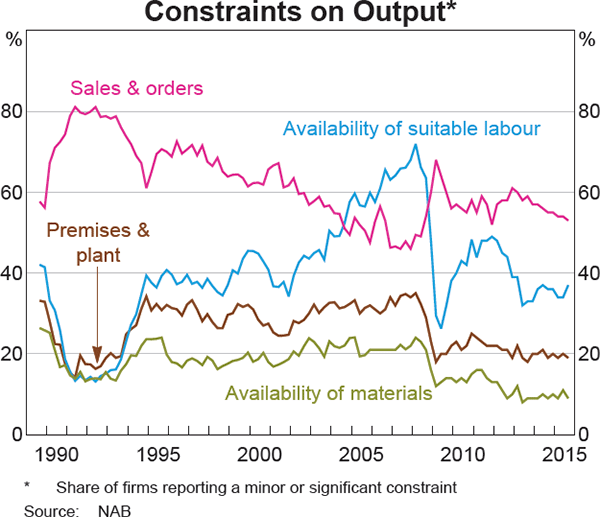
How Do Firms Interpret ‘Capacity Utilisation’? Evidence from Liaison
It is intuitive to think of ‘capacity’ as some level of output that can be produced while fully utilising resources that cannot be varied in quantity within a short period. While this broad definition applies to all firms, discussions with business managers via the Bank's business liaison program have highlighted two key differences in the interpretation of capacity utilisation across firms.
First, there are differences in which factors of production are considered by managers when they assess both capacity and the utilisation of capacity. For example, it is common for firms in capital-intensive industries – such as manufacturing, mining and transport & storage – to consider capacity in terms of their current capital stock, while utilisation embodies some consideration of both the amount of labour required and the extent to which capital is being used (Graph 4). In contrast, much of the services sector primarily focuses on labour to assess both available capacity and utilisation rates. These differences are important, as they affect the interpretation of survey measures of capacity utilisation and their implications for firms' resourcing needs and pricing decisions. For some firms, a high level of capacity utilisation may reveal an impetus to increase hours for existing workers and hire new staff, while for others it may reflect an incentive to accumulate more capital.
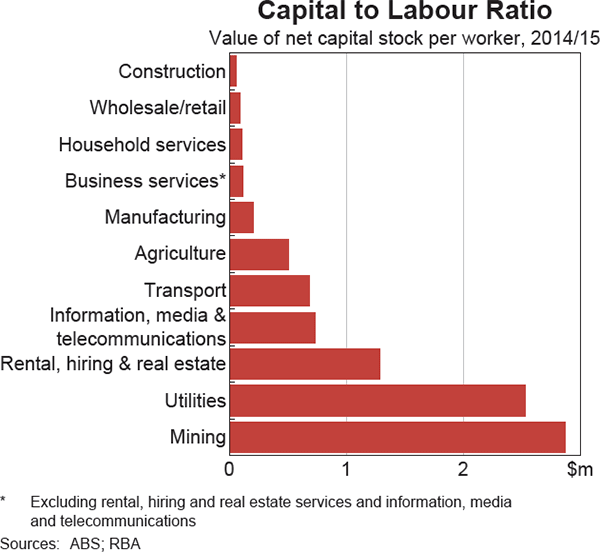
Second, the interpretation of the ‘full capacity’ level of output differs by firm. Some firms regard full capacity as the maximum level of output that can be produced with their existing capital and labour resources. Other firms regard full capacity as a desirable level of output, such as the point at which average costs are at a minimum (Graph 5).[2] This level of desirable ‘full capacity’ may be close to, or well below, the absolute maximum level of production.[3] Again, these differences affect the interpretation of survey measures of capacity utilisation. Under the first interpretation, survey reports of full capacity are more likely to be associated with more investment in capital and/or higher employment. Under the second interpretation, survey reports of full capacity might simply imply an increase in the utilisation of existing capital and labour, at least in the short run.
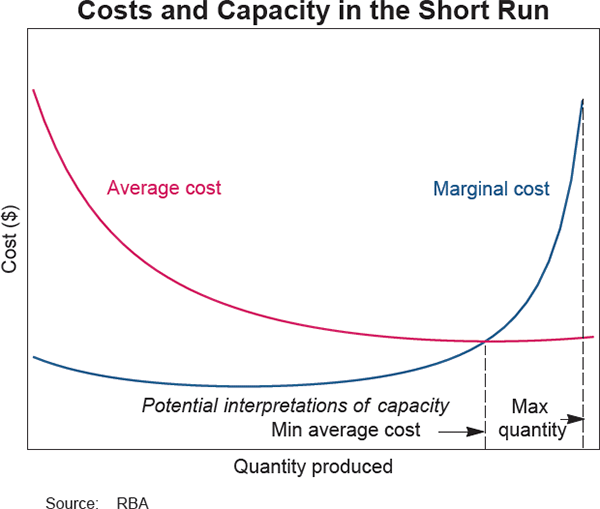
Some firms have shifted in their own thinking about utilisation over time. In particular, managers have observed a heightened focus on ‘full’ utilisation as a means of improving efficiency, suggesting that ‘average’ utilisation may have increased. In capital-intensive industries, for example, firms have used additional investment in technology to boost the utilisation of their existing physical capital stock. In the services sector, some managers explained that they had abandoned the practice of retaining ‘fat’ in their available capacity (say, 5 per cent of available hours) that was retained to meet periods of peak demand, in favour of running a ‘lean ship’ at all times. If this behaviour is widespread, comparisons of current utilisation rates with long-run averages may be misleading.
Furthermore, greater flexibility in the production process may mean the incremental response to a given change in utilisation has changed over time. This is partly due to the nature of information technology, which has become a central part of many firms' operations. Software is highly scalable and hardware is relatively cheap and increasingly accessible via options such as cloud storage technology and mobile devices. In liaison, some managers have observed that recent investment in information technology has delivered such flexibility in their business that most feasible changes in demand could be met with existing labour and physical capital inputs.
Observations by industry
Capacity utilisation is a key metric for most manufacturing firms in the business liaison program. Most use a standard form of the concept. Capacity is usually defined as the installed plant and equipment available for use and utilisation is defined as the time spent in operation (at least partly attributable to labour inputs) relative to the feasible maximum. Manufacturing firms typically qualified the ‘full’ rate of capacity as the maximum sustainable rate, recognising the costs of ‘wear and tear’. Logistics firms and mining firms generally define capacity utilisation as the actual volume of production relative to the maximum throughput during a given period of time (which could be as short as one hour). Responses from these firms were generally framed in terms of each firm's capital stock, with limited reference to labour. To varying degrees, the rate of utilisation is related to the degree of labour required in these firms.
Within the services sector, utilisation is a core metric for professional consultancies (including legal, IT and engineering & design services) and both capacity and utilisation are most commonly defined in terms of labour inputs. Consultancies generally target billable hours as a share of total hours worked, typically reviewed by management frequently. For example, many firms will target a firm-wide charge-out rate of 85 per cent of available hours (akin to ‘full capacity’ under normal conditions), with 15 per cent allocated to professional and business development. Some in the services sector were more likely to define ‘full capacity’ as their optimal rate and judged that operating above this for a sustained period was as detrimental to the business as low rates of utilisation.
Although managers in the services sector generally agreed that some contribution from capital was required in the production process, including office space, equipment and software, it is often secondary and in many cases is not factored into the regular consideration of capacity. In service firms that do not bill by the hour, most managers still consider both capacity and utilisation in terms of labour inputs, although the rate of utilisation relates to a more loose definition of staff activity. The lack of consideration of capital by many services firms possibly reflects the small share of non-labour costs, or that incremental changes in billable hours effectively factor in a capital-service charge.
Firms in some other industries expressed mixed views on the relevance of the concept of capacity utilisation for their operations. For example, construction contractors generally regarded ‘capacity utilisation’ to be of some use, primarily citing some form of labour utilisation. The focus of a ‘typical’ construction contractor in the liaison program is the time spent on each project, particularly in the detached housing market. Construction subcontractors that provide and operate capital equipment (e.g. cranes) tend to measure utilisation as the share of time that their equipment is in use.
Retailers responded that capacity utilisation was a useful concept, but not in the ‘traditional’ sense, except for distribution centre operations. Retailers commonly use revenue-based metrics as the main means of evaluating operations, such as sales density (sales per square metre or sales per employee). Cost-based metrics are also used, often to compare labour utilisation. For example, wages as a percentage of sales may be used to evaluate within-store performance over time and relative performance against other stores or regions. Household-service firms that operate physical facilities, such as restaurants and gyms, use patronage as a share of maximum (perhaps at peak times) to measure utilisation. These firms often noted that the capacity of existing facilities could not easily be expanded.
Implications for Labour and Capital Demand
Evidence from liaison suggests that the assessment of utilisation in capital-intensive industries typically embodies some consideration of both labour and capital inputs, while much of the services sector primarily focus on labour to assess available capacity and utilisation rates. For firms in the more capital-intensive goods-related industries, a high level of capacity utilisation may reveal an impetus to increase employment and to invest in the capital stock, while for services firms it may reflect only an incentive to increase the use of labour. Consequently, movements in aggregate measures of capacity utilisation are more likely to contain information about the labour market than about the capital stock. Indeed, aggregate capacity utilisation is highly correlated with measures of labour market utilisation (Graph 6).[4] Meanwhile, measures of capacity utilisation are likely to contain a meaningful degree of information about the capital stock for a subset of industries that are capital intensive.
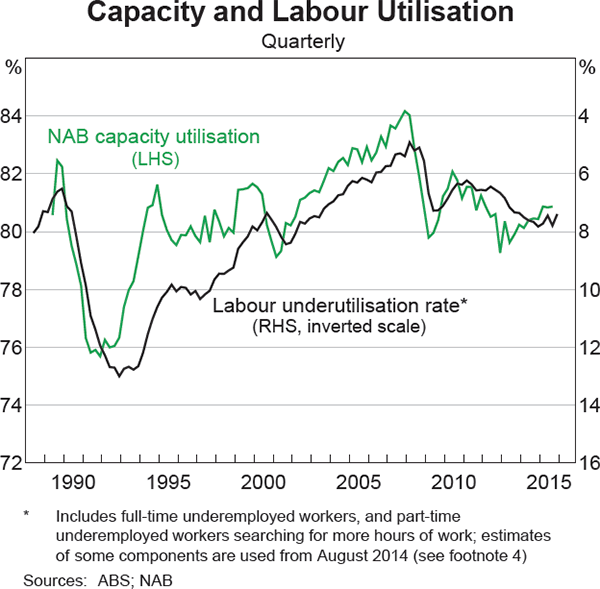
In order to meet fluctuations in demand, changes in labour input play a central role in the short run, including over periods of several months, and this was reflected in discussions with managers about their theoretical response to a strong increase in demand. Among a diverse set of responses, a relatively common approach was to employ additional hours for existing staff, then additional contract labour and then additional permanent staff. In contrast, there was a widespread reluctance to invest in capital in order to raise output to meet higher demand in the short run and even over a period of years. The increase in capacity utilisation in the services sector in recent years and the corresponding improvement in activity more broadly in this sector can partly help to explain why aggregate employment growth has picked up notably despite below-average GDP growth and weak investment.[5]
The rate of capacity utilisation is likely to have a more granular relationship with the need for new capital. Although an increase in headcount may require some capital expenditure in the services sector, the incentive to expand the capital stock can be more easily inferred from measures of capacity utilisation of firms in the goods industries. For these firms, high rates of utilisation are likely to imply a need for additional capital, leading to higher net investment (Graph 7).
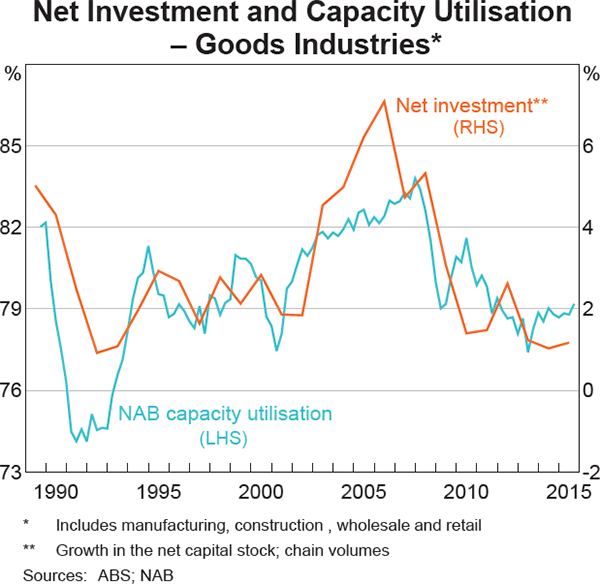
Theory points to several reasons why firms may invest in additional capital only when utilisation of existing capital is very high. Firms often incur costs of adjusting to a higher capital stock, for example disruptions to business-as-usual operations. If these adjustment costs tend to be large even for small changes in the capital stock, firms are more likely to wait until a substantial adjustment is needed.[6] Similarly, small incremental expansions in the capital stock may not be possible or practical due to the ‘lumpy’ nature of capital investment. Finally, managers may have concerns about the durability of any observed strengthening in demand. In the face of uncertainty and if investments are somewhat irreversible, waiting may be valuable since additional time affords managers the chance to avoid loss-making investments (Dixit and Pindyck 1994).[7]
These factors suggest that the distribution of survey responses about capacity utilisation may also contain information about the need for new capital.[8] In particular, firms in goods-related sectors operating at very high rates of utilisation are most likely to consider investing in additional capital. Since the global financial crisis, some liaison contacts have reported heightened uncertainty or aversion to risk, which suggests that full utilisation of available capacity may be a stronger-than-usual prerequisite for capital expenditure.[9]
Not all capital expenditure is motivated by the presence of capacity constraints. Firms can invest to increase the efficiency of current production. Many firms in liaison have described investment plans that are unrelated to the degree of spare capacity, including on software and R&D, which forms a growing share of aggregate business investment (Graph 8).[10] For example, expenditure on information technology has been described by some managers in the liaison program in the context of cost-cutting initiatives and by others as ‘future proofing’ the business, or streamlining existing operations in preparation for a possible future expansion.
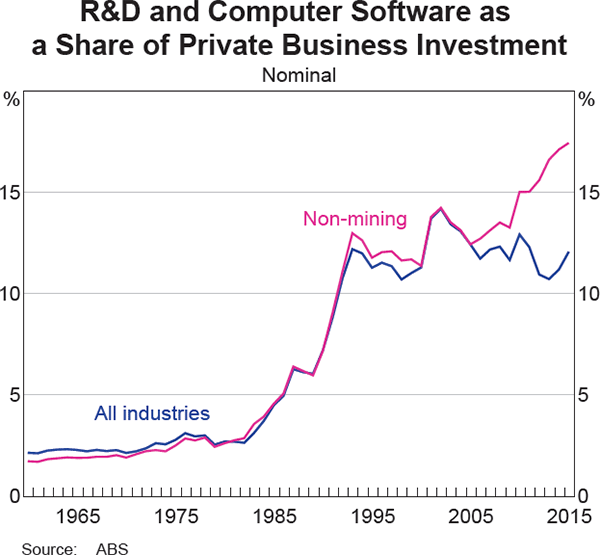
Furthermore, liaison evidence does suggest that some investment is targeted at increasing utilisation of existing physical capacity. For example, a considerable volume of refurbishment work is under way in the short-term accommodation sector. The ongoing commitment to spending on technology by a broad range of firms may also partly be framed in terms of increasing utilisation of existing capital. An individual firm may also invest to expand into new markets, regardless of the utilisation of their capacity in existing markets.[11]
Implications for Consumer Price Inflation
In principle, the rate of capacity utilisation should be positively related to the rate of inflation. At an aggregate level, inflationary pressure is likely to be greater in an economy operating at a high level of capacity utilisation than if it is operating at a low level. For example, firms may have a greater degree of pricing power and be able to expand their mark-ups in an economy experiencing strong growth in demand relative to available supply.[12] Cost pressures may also be elevated due to strong competition for available capital and labour inputs by firms seeking to expand production.
For individual firms, the mechanics of how capacity utilisation is related to cost and price inflation varies by industry. For example, a manufacturer may boost production by increasing the ‘work week’ of capital and by commensurately increasing the labour and production inputs. This may lead to higher or lower costs depending on the nature of the adjustment (Bresnahan and Ramey 1994); increasing output temporarily by paying staff overtime may lead to higher costs, whereas adding a new shift will generally lead to a decline in average costs as the additional output is generated from the same base of fixed costs.
For many service-producing firms, an increase in utilisation will be associated with an increase in the share of hours worked that are related to the provision of services. The implied increase in labour productivity will be associated with a decline in average costs unless the higher productivity is rewarded with higher remuneration. For firms in both goods-related and service industries, increasing output beyond some level without adding to capacity becomes very costly or impractical. For example, for a manufacturer running continuously with a given set of equipment, adding employees would have little effect on output. Therefore, at high rates of utilisation, a small increase in output would require a large increase in costs.[13]
Empirically, capacity utilisation has generally not had a strong concurrent relationship with consumer price inflation in Australia. (Although the very high rates of utilisation recorded before the financial crisis did coincide with rising wage growth and, in time, with a strong increase in the rate of underlying inflation.) Capacity utilisation does, however, appear to have been more closely correlated with growth of domestic producer prices (Graph 9). This is largely because consumer prices are more sensitive to the cost of imports, which reflect movements in the exchange rate and capacity pressures in overseas markets (Chung, Kohler and Lewis 2011). In addition, when inflation expectations are anchored, firms may ‘look through’ temporary changes in costs when setting final prices charged to consumers (Gillitzer and Simon 2015).[14]
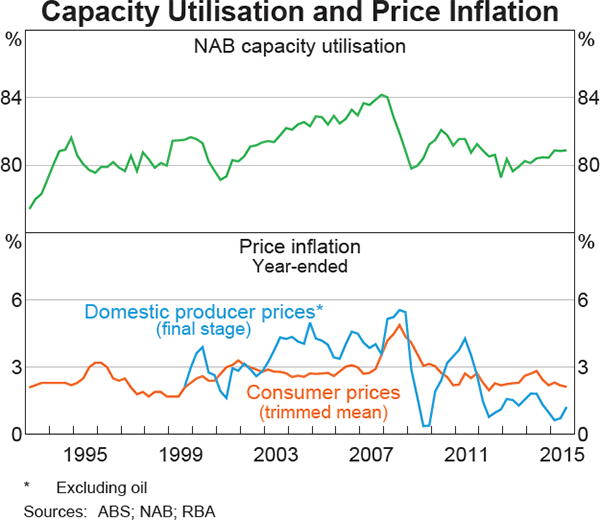
Conclusion
Discussions with company managers in the Reserve Bank's business liaison program suggest that the interpretation of ‘capacity utilisation’ varies greatly across the economy. Managers consider a range of factors when assessing utilisation, and the interpretation of ‘full’ and ‘optimal’ capacity also varies across industries. These differences affect the interpretation of survey measures of capacity utilisation and their implications for firms' demand for labour and capital. Firms in capital-intensive industries, such as manufacturing, mining and transport & storage, tend to consider available capacity in terms of their capital stock, while the assessment of utilisation typically embodies some consideration of both labour and capital inputs. In contrast, much of the services sector primarily focuses on labour to assess capacity utilisation. Firms' responses help to explain why developments in the labour market are an important driver of overall trends in measured capacity utilisation. For investment, the rate of capacity utilisation at an individual firm is potentially a valuable indicator of their incentive to add to their stock of physical capital. In particular, firms in goods-related sectors operating at very high rates of utilisation are most likely to consider investing in additional capital. For other firms, capacity utilisation bears less direct relationship to subsequent changes in the capital stock. Finally, the relationship between capacity utilisation and consumer price pressures is weaker than it is with upstream domestic price pressures. This may, in part, reflect the effect of well-anchored expectations regarding consumer price inflation.
Footnotes
The authors are from Economic Analysis Department and thank Alice Lam and Mike Major for valuable input to this article. [*]
The Reserve Bank business liaison team conducts around 70–80 discussions with contacts on a monthly basis. Discussions with any individual firm typically occur around every 6 to 12 months, with Bank staff usually meeting the chief executive officer, chief financial officer and/or operations manager. Liaison meetings are held with firms of all sizes, although most discussions are with mid-sized and large firms where conditions are somewhat more likely to reflect economy-wide trends rather than firm-specific factors. For more information, see RBA (2014). [1]
This ambiguity of capacity utilisation was discussed throughout the 20th century, including by Cassel (1937) and Friedman (1963). See Christiano (1981) or Nelson (1989) for a review. [2]
Eiteman and Guthrie (1952) sent a survey to manufacturers in the United States presenting them with several depictions of average cost curves. Of the 366 respondents, the majority indicated that capacity output was at, or only a little above, the level of production where the curve was at a minimum. Capacity was defined in the survey as ‘meaning the maximum output possible without the use of overtime payments for labor’. [3]
The underemployment measure used in Graph 6 comprises part-time workers who are actively looking to work more hours and full-time workers who have been temporarily put on shorter hours for economic reasons (such as insufficient work available), weighted by an estimate of the additional hours that they want to work; see RBA (2004). This measure differs from the ABS measure of underutilisation, in that it only includes part-time workers who are actively looking to work more hours, not those who prefer to work more hours but are not actively searching for more work. Some of the components published by the ABS are temporarily unavailable after May 2014, and thereafter it is assumed that full-time (or part-time) underemployed workers as a share of full-time (or part-time) employment remained around its average in the year to May 2014. [4]
See RBA (2015) for details. [5]
See Chirinko (1993) for a useful discussion. [6]
McDonald (2000) suggests that this ‘option value of waiting’ may explain why many businesses tend to use hurdle rates for investment decisions that are above their cost of capital. Lane and Rosewall (2015) found that many Australian firms use relatively high hurdle rates, although they note that the value of real options was never invoked by liaison contacts as an explanation. [7]
For a discussion of these factors, along with related evidence that higher moments of Tobin's q are likely to be relevant in explaining capital expenditure, see Eberly (1997), Caballero, Engel and Haltiwanger (1995) and Caballero and Engel (1999). [8]
Lowe (2013) observed that business confidence and the willingness to take risk was subdued in Australia and partly attributed this to a ‘legacy of the financial crisis’. Haldane (2015) suggests that the financial crisis may have caused heightened perceptions of, and aversion to, risk amongst managers in the United Kingdom. [9]
The intellectual property component of capital expenditure has not exhibited strong cyclical patterns to date (Elias and Evans 2014). [10]
It is possible that this type of speculative spending may be more palatable to firms when they observe others investing heavily: firms may fear losing market share if they invest less than their competitors; they might extract information from the behaviour of others; or they might consider the reputation damage from initiating failed projects to be less (Scharfstein and Stein 1990). [11]
For example, in the United Kingdom, Weale (2014) found a positive relationship between margins and capacity utilisation. There is little evidence that mark-ups have been countercyclical in Australia; see Norman and Richards (2012). [12]
The ‘wear and tear’ costs of running at high utilisation rates may also factor into the operational and pricing decisions of manufacturers and other capital-intensive businesses. [13]
Relatedly, Heath, Roberts and Bulman (2004) suggest that a decline in inflation expectations in the 1990s led to a slowing in the pace with which changes in import prices were passed through to final consumer prices. [14]
References
Bresnahan T and V Ramey (1994), ‘Output Fluctuations at the Plant Size’, Quarterly Journal of Economics, 109, pp 593–624.
Caballero RJ and EM Engel (1999), ‘Explaining Investment Dynamics in US Manufacturing: A Generalized Approach’, Econometrica, 67(4), pp 783–826.
Caballero RJ, EM Engel, JC Haltiwanger (1995), ‘Plant-Level Adjustment and Aggregate Investment Dynamics’, Brookings Papers on Economic Activity, 1995(2), pp 1–54.
Cassel G (1937), ‘Keynes’ “General Theory” ‘, International Labour Review, 36(4), pp 437–445.
Chirinko RS (1993), ‘Business Fixed Investment Spending: Modeling Strategies, Empirical Results, and Policy Implications’, Journal of Economic Literature, 31(4), pp 1875–1911.
Christiano LJ (1981), ‘A Survey of Measures of Capacity Utilization’, Staff Papers (International Monetary Fund), 28(1), pp 144–198.
Chung E, M Kohler and C Lewis (2011), ‘The Exchange Rate and Consumer Prices’, RBA Bulletin, September, pp 916.
Dixit AK and RS Pindyck (1994), Investment under uncertainty, Princeton University Press, Princeton.
Eberly JC (1997), ‘International Evidence on Investment and Fundamentals’, European Economic Review, 41(6), pp 1055–1078.
Eiteman WJ and GE Guthrie (1952), ‘The Shape of the Average Cost Curve’, The American Economic Review, 42(5), pp 832–838.
Elias S and C Evans (2014), ‘Cycles in Non-mining Business Investment’, RBA Bulletin, December, pp 1–6.
Friedman M (1963), ‘More on Archibald versus Chicago’, The Review of Economic Studies, 30, pp 65–67.
Gillitzer C and J Simon (2015), ‘Inflation Targeting: A Victim of Its Own Success?’, International Journal of Central Banking, 11(4), pp 259–287.
Haldane (2015), ‘Stuck’, Speech at the Open University, London, 30 June.
Heath A, I Roberts and T Bulman (2004), ‘Inflation in Australia: Measurement and Modelling’, in Kent C and S Guttmann (eds), The Future of Inflation Targeting, Proceedings of a Conference, RBA, Sydney, pp 167–207.
Lane K and T Rosewall (2015), ‘Firms' Investment Decisions and Interest Rates’, RBA Bulletin, June, pp 1–8.
Lowe P (2013), ‘Investment and the Australian Economy’, Address to the CFA Australia Investment Conference 2013, Melbourne, 24 October.
McDonald RL (2000), ‘Real Options and Rules of Thumb in Capital Budgeting’, in M Brennan and L Trigeorgis (eds), Project Flexibility, Agency, and Competition, Oxford University Press, Oxford, pp 13–33.
Nelson RA (1989), ‘On the Measurement of Capacity Utilization’, The Journal of Industrial Economics, 37(3) pp 273–286.
Norman D and A Richards (2012), ‘The Forecasting Performance of Single Equation Models of Inflation’. Economic Record, 88(280), pp 64–78.
RBA (Reserve Bank of Australia) (2004), ‘Box B: Indicators of Labour Market Tightness’, Statement on Monetary Policy, November, pp 35–36.
RBA (2014), ‘The RBA's Business Liaison Program’, RBA Bulletin, September, pp 1–5.
RBA (2015), ‘Box C: Developments by Sector’, Statement on Monetary Policy, November, pp 43–46.
Scharfstein DS and JC Stein (1990), ‘Herd Behavior and Investment’, The American Economic Review, 80(3), pp 465–479.
Weale M (2014), ‘Spare Capacity and Inflation’, Speech to the Confederation of British Industry, Belfast, 18 June.